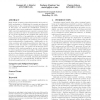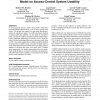CODASPY
2012
12 years 8 months ago
2012
Main stream operating system kernels lack a strong and reliable mechanism for identifying the running processes and binding them to the corresponding executable applications. In t...
IACR
2011
13 years 2 days ago
2011
—Contactless technology is widely used in security sensitive applications, including identification, payment and access-control systems. Near Field Communication (NFC) is a shor...
CHI
2011
ACM
13 years 4 months ago
2011
ACM
In access-control systems, policy rules conflict when they prescribe different decisions (ALLOW or DENY) for the same access. We present the results of a user study that demonstr...
ICDIM
2010
IEEE
13 years 10 months ago
2010
IEEE
We present a risk management framework which allows to reason about and manage risk for role based access control systems. The framework expresses essential characteristics of risk...
IAT
2010
IEEE
13 years 10 months ago
2010
IEEE
There is a need for research on the scientific base and engineering requirements for building trustworthy systems in dynamic environments. To address this need, we study risk analy...
ENTCS
2007
14 years 12 days ago
2007
An access control system regulates the rights of users to gain access to resources in accordance with a specified policy. The rules in this policy may interact in a way that is n...
ESORICS
2008
Springer
14 years 2 months ago
2008
Springer
Delegation is a mechanism that allows a user A to act on another user B's behalf by making B's access rights available to A. It is well recognized as an important mechani...
SP
1997
IEEE
14 years 4 months ago
1997
IEEE
A major drawback of existing access control systems is that they have all been developed with a specific access control policy in mind. This means that all protection requirement...
COLCOM
2009
IEEE
14 years 5 months ago
2009
IEEE
Risk-based access control raises some novel problems that have not yet been investigated. In particular, the ability to aggregate uncertain risk estimations from different experts...
ACSAC
2003
IEEE
14 years 5 months ago
2003
IEEE
While publishing content on the World Wide Web has moved within reach of the non-technical mainstream, controlling access to published content still requires expertise in Web serv...






